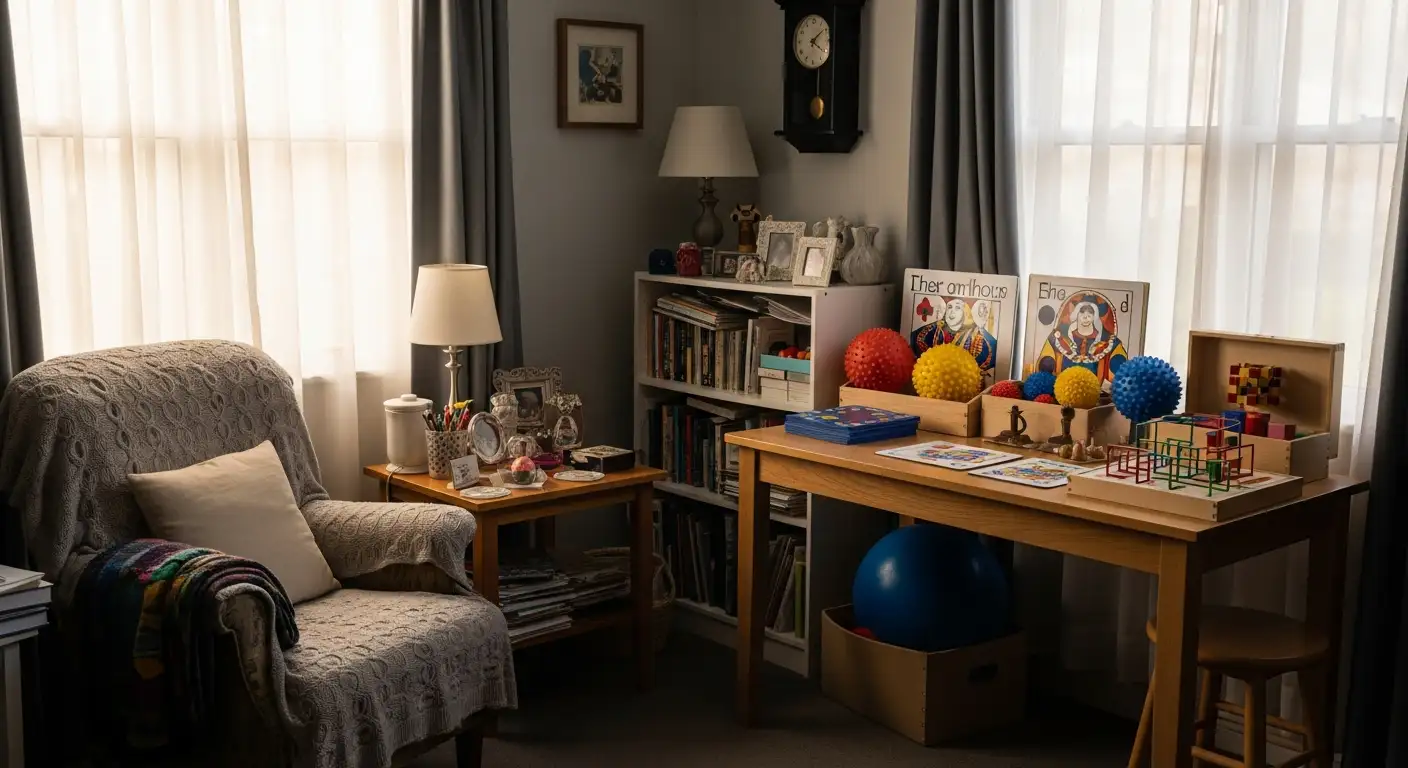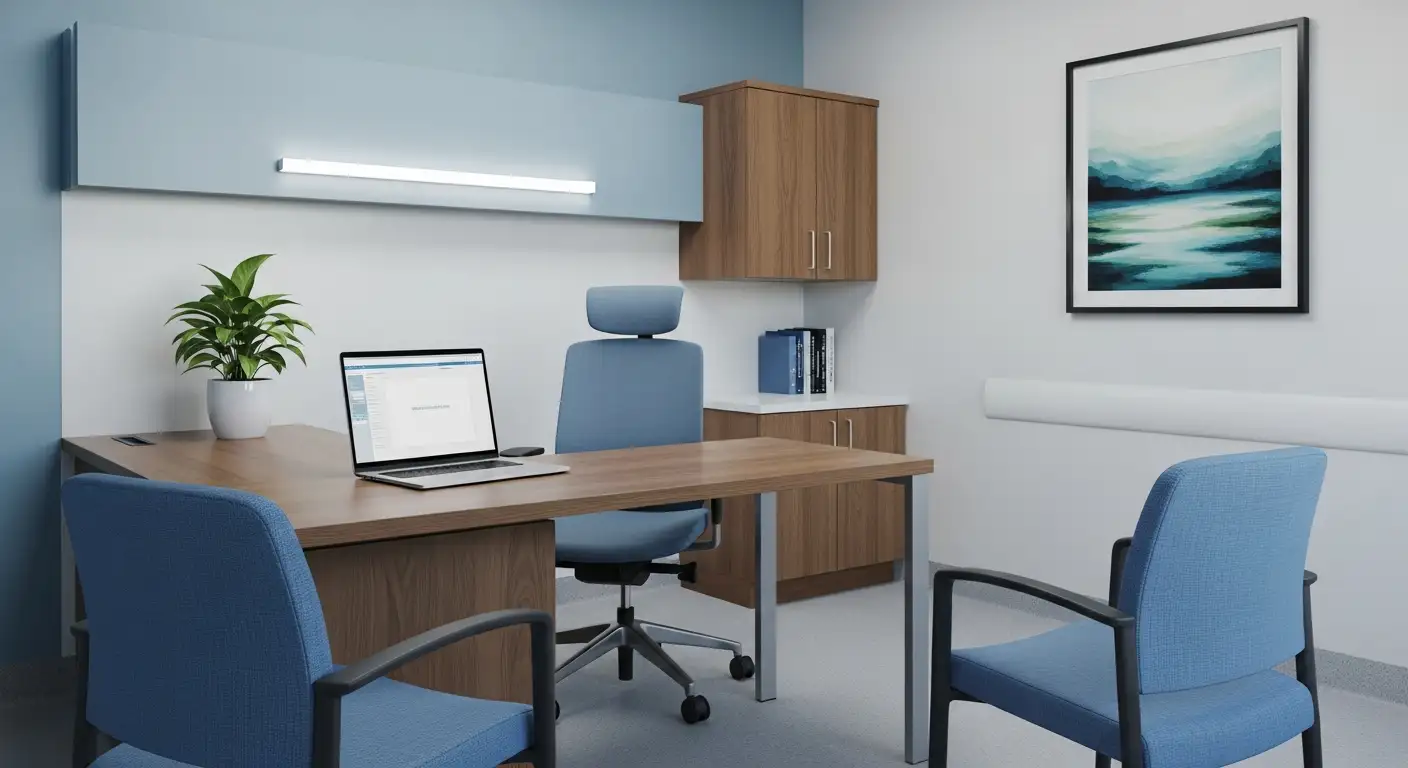Introduction to Behavioral Approaches for Dementia Agitation
Agitation is a prevalent neuropsychiatric symptom in dementia patients, characterized by restlessness, pacing, verbal outbursts, and aggression. Affecting 30-50% of individuals with dementia, it not only causes distress for patients but also imposes a significant burden on caregivers. Understanding the complex causes and effective behavioral management strategies is essential for improving quality of life and safety. This article explores various nonpharmacologic interventions, environmental modifications, caregiver techniques, and the integration of pharmacological options to manage agitation comprehensively.
Causes and Symptoms of Agitation in Dementia Patients
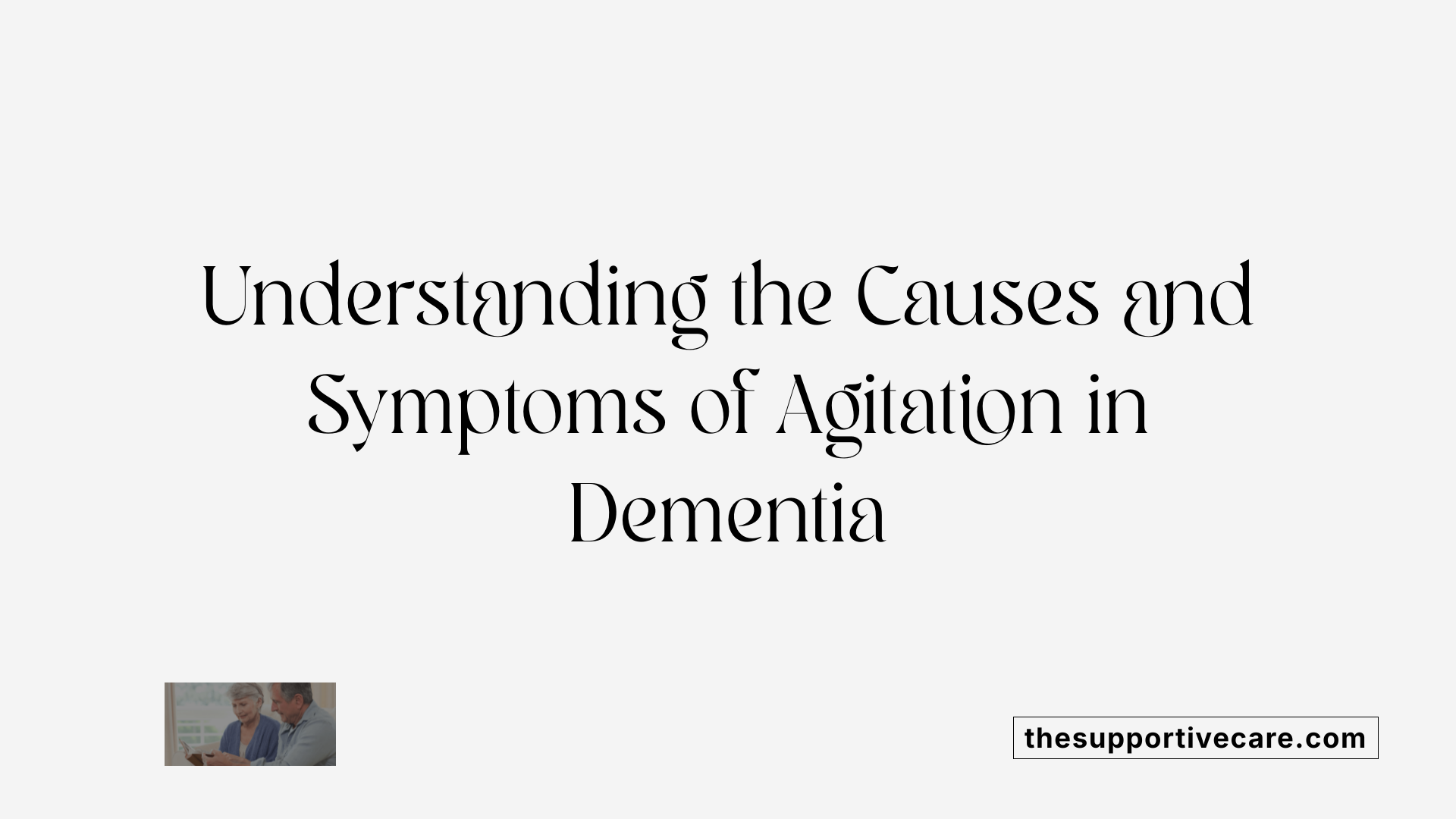
What are the causes and symptoms of agitation in dementia patients?
Agitation is a common and challenging behavioral symptom in dementia, affecting approximately 30% to 50% of those with the condition, and becoming more prevalent as the disease advances. It manifests through a variety of behaviors, including restlessness, pacing, verbal outbursts, aggression, and behaviors that tend to worsen during the late afternoon or early evening, a time often referred to as 'sundowning'.
The underlying causes of agitation in dementia are multifaceted, stemming from complex changes within the brain as well as external factors. One primary contributor is the deterioration of brain regions responsible for decision-making and emotion regulation, particularly the frontal cortex—including areas like the anterior cingulate cortex (ACC) and orbitofrontal cortex (OFC). These regions influence how salient stimuli are processed, and their dysfunction can lead to increased reactivity and difficulty in filtering environmental stimuli.
In addition, changes in noradrenergic signaling, especially a heightened sensitivity to norepinephrine due to loss of neurons in the locus coeruleus, can heighten responses to stimuli, making patients more prone to agitation. This abnormal reactivity is often triggered by environmental factors such as sudden changes in routine or surroundings, excessive noise, or low lighting conditions, especially during sundowning.
Medical conditions further complicate agitation. Pain, discomfort, infections, constipation, and fatigue are common precipitating factors. For example, an unmet need such as hunger, thirst, or the urge to use the bathroom can trigger agitation if not promptly addressed. Sensory impairments like poor vision or hearing can also contribute by increasing confusion and distress.
Psychological factors play a significant role too. Feelings of loss, loneliness, fear, and anxiety, often exacerbated by cognitive decline and unfamiliar environments, can lead to emotional distress and agitation. Sudden changes in routine or environment, including hospitalization or transfer to care facilities, are stressors that aggravate these symptoms.
Symptoms of agitation are diverse but consistently involve increased motor activity and emotional distress. Common behaviors include pacing, repetitive movements, loud vocalizations, verbal outbursts, and occasionally physical aggression such as hitting or threatening. During sundowning, these behaviors intensify, and the individual may appear more confused or paranoid.
Effective management begins with identifying and addressing these underlying causes. Creating a calm and familiar environment, maintaining routines, and reducing environmental stressors can significantly diminish agitation episodes. Caregivers should monitor physical comfort regularly and simplify routines to reduce confusion. When triggers are identified, strategies such as reassurance, distraction with engaging activities, music therapy, and gentle physical contact can help soothe the individual.
In some cases, pharmacological intervention might be necessary, but safeguarding against side effects is crucial. Overall, understanding the complexity of agitation—including brain mechanisms, triggers, and behavioral signs—allows caregivers and clinicians to tailor interventions more effectively, improving quality of life for individuals living with dementia.
Nonpharmacologic Strategies for Managing Agitation
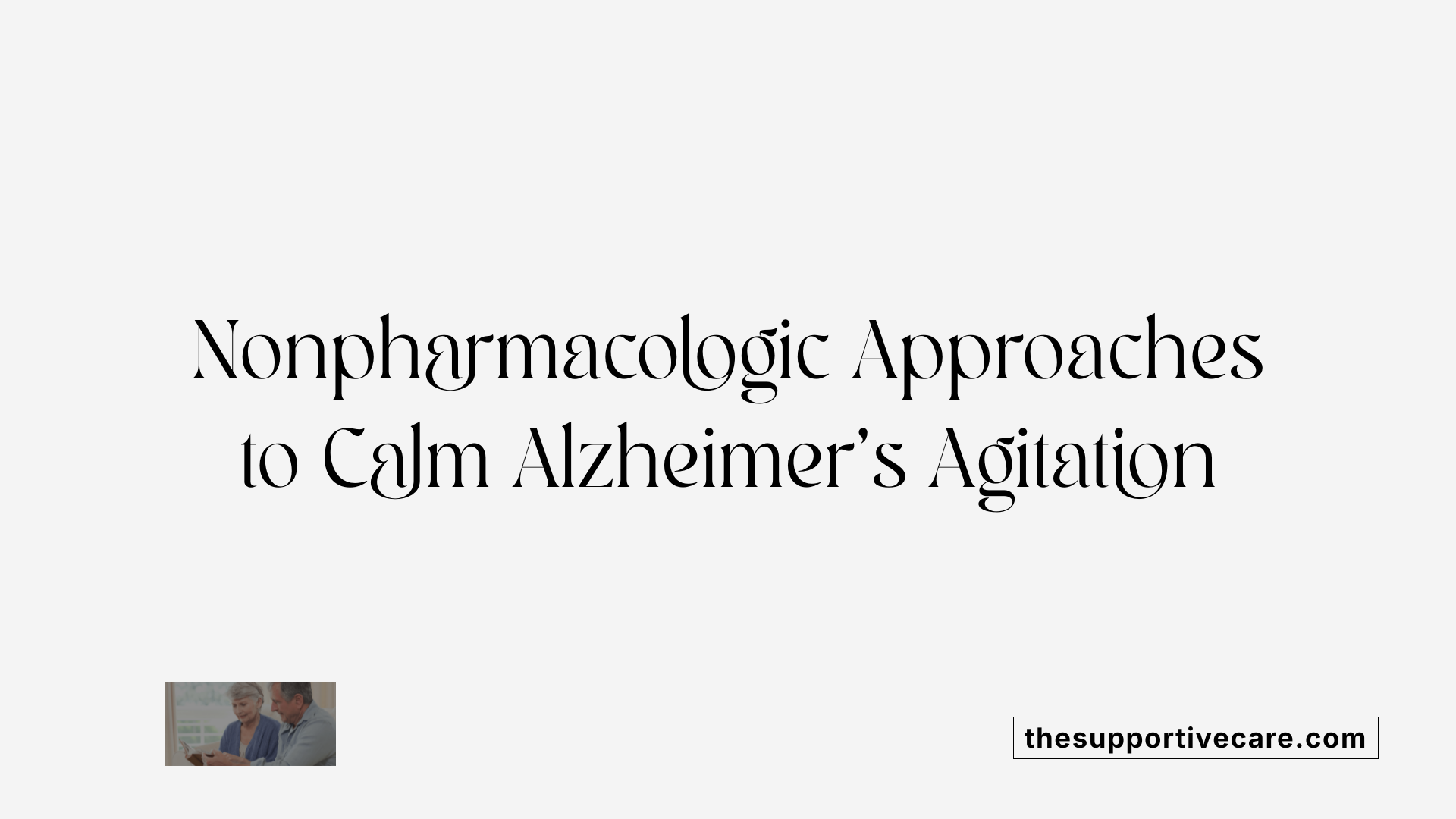 Effective nonpharmacologic strategies for managing agitation in dementia focus on creating a calming, engaging, and supportive environment that addresses individual needs. Sensory-based therapies are a cornerstone of these approaches. Music therapy, aromatherapy, and therapeutic touch can soothe the person and reduce agitation. For example, playing familiar music or nature sounds can help them relax. Bright light therapy can also improve mood and sleep, indirectly decreasing behavioral symptoms.
Effective nonpharmacologic strategies for managing agitation in dementia focus on creating a calming, engaging, and supportive environment that addresses individual needs. Sensory-based therapies are a cornerstone of these approaches. Music therapy, aromatherapy, and therapeutic touch can soothe the person and reduce agitation. For example, playing familiar music or nature sounds can help them relax. Bright light therapy can also improve mood and sleep, indirectly decreasing behavioral symptoms.
Activity-oriented interventions are equally important. Reminiscence therapy, where caregivers use pictures, familiar objects, or storytelling from the past, can evoke positive emotions. Artistic activities like painting or crafts, as well as gardening or physical exercises such as walking and dancing, serve as outlets for energy and reduce restless behaviors.
Education and training for caregivers and staff form a fundamental part of nonpharmacologic management. Learning behavioral management techniques, understanding triggers, and knowing how to modify the environment help prevent agitation episodes. For example, reducing noise levels, maintaining a comfortable temperature, and ensuring a clutter-free space minimize overstimulation.
Personalized approaches are highly effective. Maintaining consistent routines, using gentle, simple language, and providing reassurance and validation of feelings help the person feel safe and understood. Redirecting attention to calming activities—like listening to music or engaging in a favorite hobby—can defuse distress.
In summary, combining sensory interventions, engaging activities, caregiver education, and personalized routines can significantly reduce agitation without the risks associated with medications. These strategies are considered first-line and should be tailored to each individual’s preferences and needs for best results.
Preventing Agitation Through Proactive Care
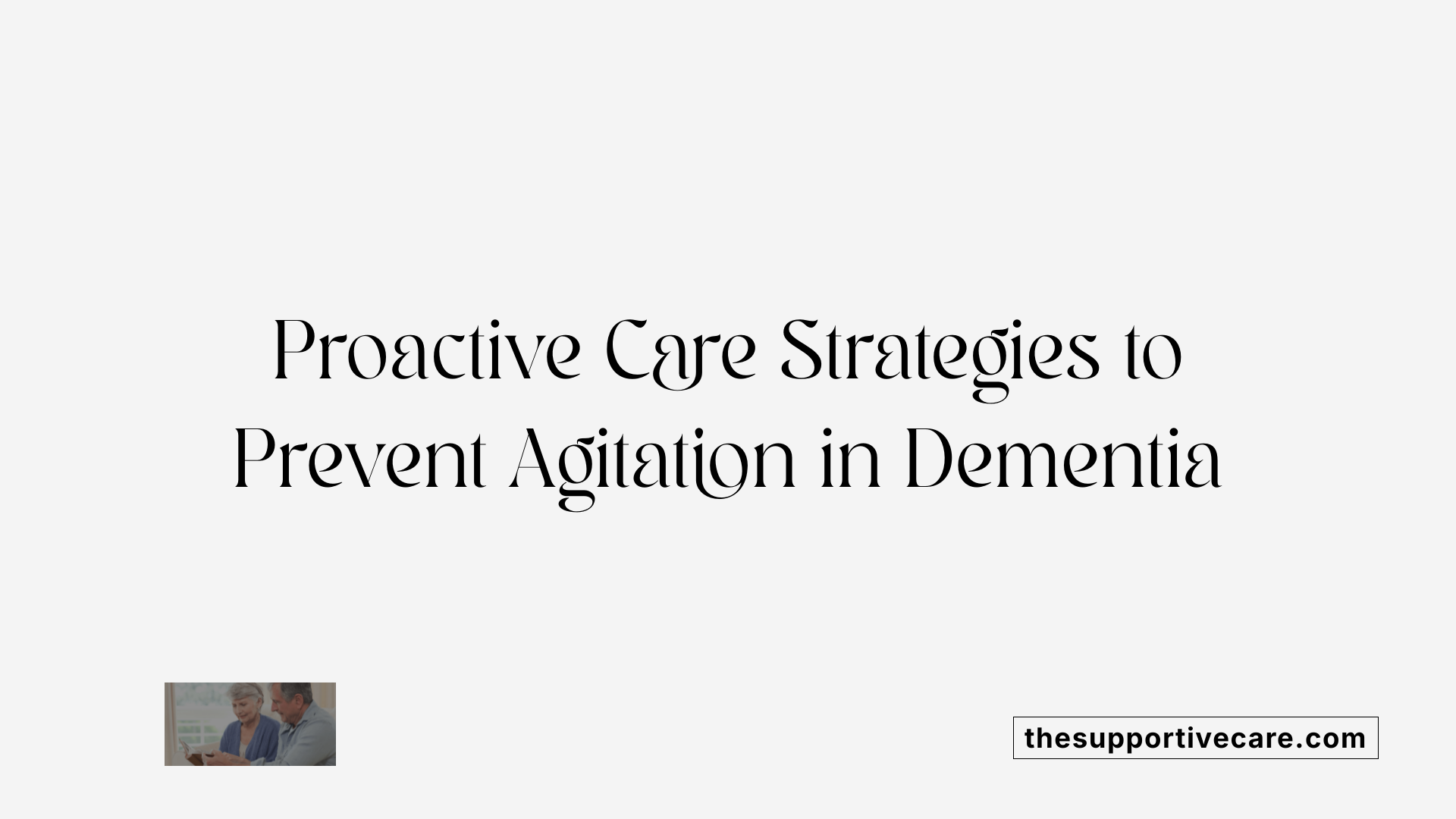
What are best practices for preventing agitation in dementia patients?
Preventing agitation in dementia patients requires a thoughtful approach that emphasizes creating a peaceful and familiar environment. Maintaining a consistent routine helps reduce confusion and anxiety, which can trigger agitation. It’s important to keep the surroundings calm by minimizing noise, dimming harsh lighting, and removing clutter or reflective surfaces that might cause overstimulation.
Addressing physical discomfort is also crucial. Regularly check for signs of pain, hunger, thirst, fatigue, or the need for toileting. Proper management of these needs can prevent frustration and distress.
Engaging patients in meaningful activities tailored to their preferences and abilities offers a sense of purpose and reduces boredom. Examples include listening to favorite music, gentle walks, or sensory stimulation exercises. Such activities not only provide comfort but also help channel excess energy positively.
Implementing person-centered care strategies, such as validating feelings rather than correcting perceptions, and reacting with patience and reassurance, maintain emotional stability. It’s also vital to manage environmental triggers like glare, loud noises, or sudden changes that can provoke agitation.
Regular medical evaluations are recommended to identify and treat underlying causes like infections, adverse medication effects, or unmanaged medical conditions. Overall, a combination of environmental adjustments, addressing physical needs, personalized engagement, and ongoing health assessments can significantly reduce the risk of agitation in dementia patients.
Role of Behavioral Interventions in Managing Agitation
How can behavioral interventions help manage agitation in dementia patients?
Behavioral methods are a foundational aspect of caring for individuals with dementia experiencing agitation. These approaches focus on understanding and addressing the specific triggers that set off agitation, such as environmental changes, discomfort, or routine disruptions. By identifying these triggers, caregivers can modify the surroundings to make them more calming, reduce overstimulation, and create a sense of familiarity.
Utilizing reassurance, validation, and distraction techniques is particularly effective. For example, gently affirming the person’s feelings, redirecting their attention to calming activities like listening to music or engaging in simple art projects, and maintaining a calm, reassuring tone can significantly reduce distress.
Implementing structured routines and offering personalized activities that align with the individual’s history and preferences help provide stability, reduce confusion, and prevent escalation.
Regular monitoring allows caregivers to observe the individual’s response to different strategies. Adjustments can then be made, such as changing activities or environmental cues, to optimize comfort.
Non-pharmacological techniques, including environmental modifications, maintaining routines, staff and caregiver education, and sensory stimulation, are recommended as the first line of intervention. These strategies aim to manage agitation safely and reduce reliance on medication. When symptoms are severe or unmanageable through behavioral means alone, medications like SSRIs or careful use of antipsychotics may be considered, always with careful evaluation of risks.
In summary, personalized, person-centered care that emphasizes understanding the individual’s needs and modifying the environment accordingly is crucial for effective management of agitation in dementia. This approach promotes safety, dignity, and improved quality of life for both patients and caregivers.
Recognizing and Assessing Neuropsychiatric Symptoms
Caregivers play a crucial role in identifying symptoms of agitation and related behavioral issues in dementia patients. They should look for signs such as increased physical activity, pacing, verbal outbursts, or emotional distress, which often occur alongside communication difficulties or marked changes in mood.
Monitoring the frequency, duration, and possible triggers of these behaviors helps in understanding the situation better. Environmental factors, such as poor lighting, noise, or recent changes in routine, can also influence agitation levels.
To objectively evaluate these symptoms, healthcare providers recommend using standardized assessment tools. Common scales include the Cohen-Mansfield Agitation Inventory (CMAI), which measures agitation severity, and other instruments like the Behavioral Activity Rating Scale (BARS) or the Agitated Behavior Scale (ABS). These tools help quantify behavioral disturbances, guiding treatment plans.
Regular assessment is vital, especially when symptoms emerge or worsen. Caregivers should document any new behaviors or escalation in existing agitation to facilitate professional evaluation.
Evaluating triggers involves examining environmental influences, recent changes in routine, unmet needs such as pain or hunger, or medical issues like infections. An accurate assessment helps distinguish behavioral symptoms caused by mood, physical discomfort, or environmental factors.
Collaboration with healthcare professionals ensures a comprehensive assessment. Clinicians can perform physical examinations, review medications for side effects, and consider underlying medical or psychiatric conditions that may contribute. This integrated approach aids in developing appropriate care strategies.
More information can be sought by searching for "assessing agitation in dementia caregivers," which offers resources and guidance on effective evaluation techniques and support systems for caregivers.
Pharmacological Options and When They Are Used
What are pharmacological options for managing agitation in dementia?
Medications are considered when behavioral symptoms like agitation become severe, pose safety risks, or significantly diminish quality of life. Among available options, antipsychotics such as risperidone, olanzapine, and aripiprazole are notable for their ability to reduce agitation in the short term. However, their use is associated with serious risks, including increased chances of stroke, mortality, and metabolic problems. Consequently, they should be used with caution, at the lowest effective dose, and for the shortest duration possible.
SSRIs like citalopram, sertraline, and escitalopram have gained support through clinical studies as effective and safer alternatives, especially when agitation is linked to depression or irritability. They tend to have fewer adverse effects and are often utilized as part of a comprehensive behavioral approach.
Other agents such as dextromethorphan combined with quinidine have shown promise in clinical trials, demonstrating significant reduction in agitation scores. Nonetheless, their side effect profile requires careful assessment before use.
Memantine and cholinesterase inhibitors (like donepezil or rivastigmine) may offer additional benefits, particularly in Alzheimer's disease, by subtly improving behavioral symptoms.
Importantly, pharmacological treatment should be viewed as adjunctive rather than primary, and only after non-drug strategies—like environmental modifications and caregiver interventions—have been tried. Regular monitoring of side effects, efficacy, and medication safety is essential. Discontinuing or adjusting medications based on patient response can reduce adverse outcomes and improve overall care.
Integrating these medications with tailored behavioral therapies, routine monitoring, and caregiver support provides a balanced approach, aiming to manage agitation effectively while minimizing risks.
Handling Challenging Behaviors and Ensuring Safety
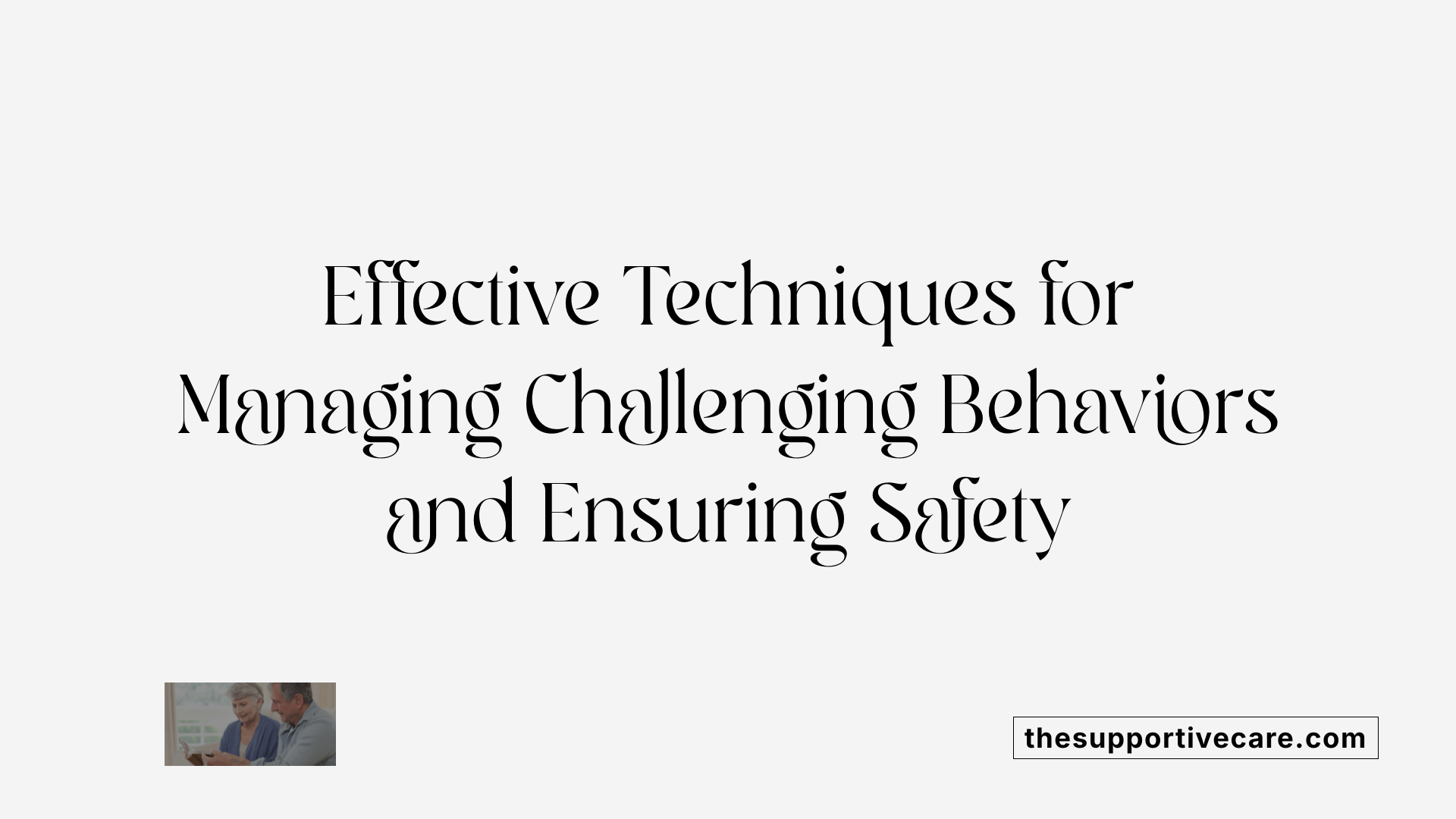
What are effective techniques for handling challenging behaviors stemming from agitation in dementia?
Managing agitation-related behaviors in individuals with dementia requires a compassionate and systematic approach. The first step involves creating a calming environment by minimizing noise, shadows, and reflective surfaces that can overstimulate or confuse the person. Maintaining a calm, reassuring tone during interactions helps reduce stress and prevents escalation.
Identifying and addressing underlying triggers is crucial. Common causes include unmet needs like hunger, thirst, pain, or discomfort, as well as environmental changes, illness, or side effects of medications. Conducting a medical evaluation can uncover physical health issues contributing to aggressive or agitated behaviors.
Distraction techniques can be highly effective. Engaging the individual in simple, pleasurable activities, such as music therapy, gentle exercise, or reminiscence, helps divert their attention away from distressing stimuli. Reassurance, validation of feelings, and gentle touch can foster a sense of safety and emotional connection.
Non-pharmacological strategies are preferred initially. Person-centered care that considers the person’s history, preferences, and current needs should guide their activities and interactions. When behaviors become dangerous or unmanageable, consulting healthcare professionals for medication options becomes necessary, with drugs like antipsychotics used cautiously and only as a last resort.
Additional safety measures include thoughtful monitoring following the ABC model—trying to understand the Antecedent (trigger), Behavior, and Consequences—to prevent triggers and manage responses effectively.
Involving family members and professionals in care planning ensures a supportive environment tailored to the individual. Training caregivers in de-escalation techniques, emotional support, and safe management of agitation enhances safety and preserves dignity.
By combining these approaches—creating a tranquil setting, understanding triggers, engaging in non-physical calming activities, and ensuring a supportive environment—caregivers can better handle challenging behaviors and promote safety for everyone involved.
Differentiating Behavioral and Medical Approaches
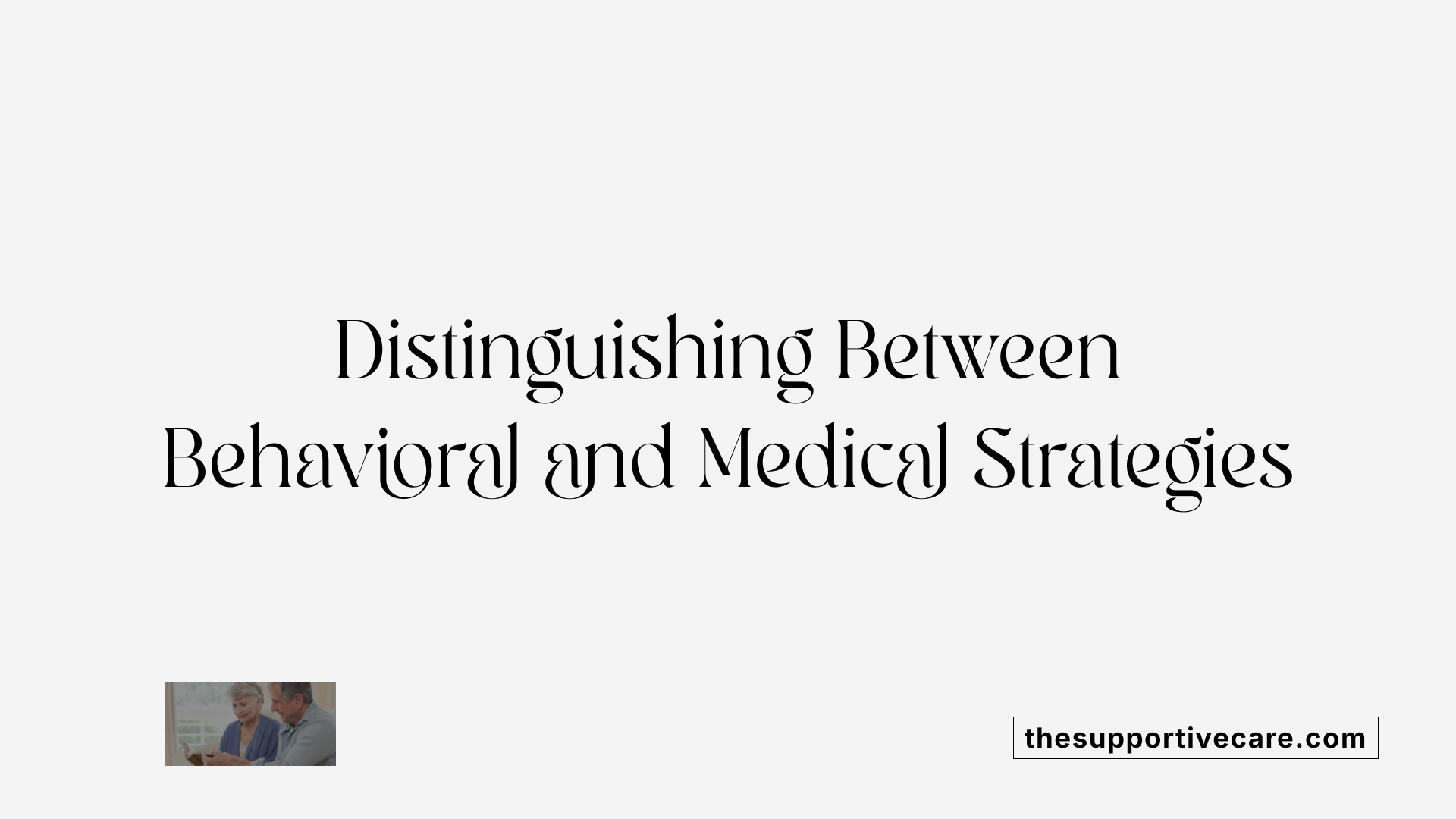 In managing agitation among dementia patients, understanding the distinction between behavioral and medical strategies is essential for effective care.
In managing agitation among dementia patients, understanding the distinction between behavioral and medical strategies is essential for effective care.
Behavioral approaches primarily focus on environmental modifications, such as maintaining routines, reducing noise, and creating calming settings. These methods also include personalized communication, engaging activities like music therapy or reminiscence, caregiver training, and techniques aimed at redirecting attention to reduce distress. The goal is to address triggers, unmet needs, or discomfort through non-drug measures, fostering a sense of safety and familiarity.
On the other hand, medical approaches involve the use of medications like antipsychotics, SSRIs, and other agents. These are typically considered when agitation significantly threatens safety or severely impacts quality of life, especially when behavioral measures alone are insufficient. Pharmacologic treatments target neurochemical imbalances or underlying medical causes, such as pain or infections, that may contribute to agitation.
Deciding when to consider medication requires careful assessment. Safety concerns, severity of symptoms, and the potential risks versus benefits play a crucial role. For example, antipsychotics carry risks of stroke, falls, and mortality, and their use should be cautious and reserved for cases of persistent, severe agitation.
An integrated approach that combines both methods—emphasizing non-pharmacological strategies as first-line interventions—is often most effective. Tailoring these practices to individual needs ensures a person-centered care plan that addresses both environmental factors and underlying causes.
In summary, differentiating these approaches hinges on understanding their focus: behavioral strategies aim at environmental and emotional regulation, while medical treatments address biochemical and physiological factors. Combining these methods thoughtfully ensures comprehensive, safe, and personalized management of agitation in dementia care.
Conclusion and Best Practices in Agitation Management
Effectively managing agitation in dementia patients requires a comprehensive understanding of its multifactorial causes and a tailored approach combining nonpharmacologic strategies with judicious pharmacological intervention when necessary. Emphasizing environmental modification, routine, personalized engagement, caregiver education, and emotional support forms the foundation for safety and well-being. Regular assessment of behavioral and neuropsychiatric symptoms helps identify triggers and monitor progress. Collaborative care, involving healthcare professionals and caregivers, ensures that intervention plans are safe, effective, and respectful of individual needs. By integrating evidence-based methods and maintaining a compassionate, patient-centered perspective, caregivers can significantly improve outcomes and enhance the quality of life for individuals living with dementia.
References
- Coping With Agitation, Aggression, and Sundowning in Alzheimer's ...
- Anxiety & Agitation | Alzheimer's Association
- Agitation and Dementia: Prevention and Treatment Strategies in ...
- Pharmacologic Management of Agitation in Patients with Dementia
- How to Calm an Agitated Dementia Patient: 6 Proven Strategies
- Preventing and managing aggressive behaviour in people with ...
- Behavioral Approaches in Dementia Care - Practical Neurology
- Agitation and aggression - Dementia Australia
- Treatments for Behavior | Alzheimer's Association


